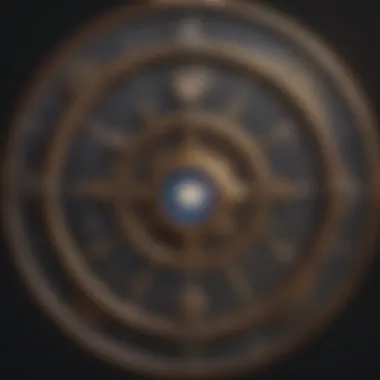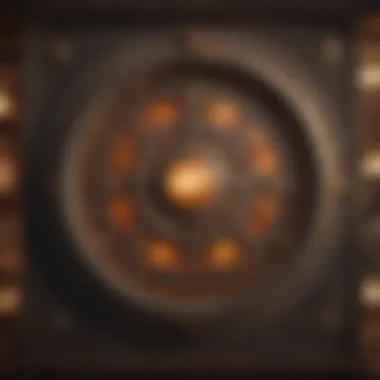Natal Chart Breakdown: A Comprehensive Guide for Astrology Enthusiasts


Intro
Understanding your natal chart can feel like peering into a complex tapestry. Each thread represents planetary positions, zodiac signs, and significant aspects of life. This map influences personal traits and behaviors.
In this article, we will guide you through many facets of natal charts. The aim is your deeper comprehension of how different elements intersect to create one’s astrological personality.
Characteristics of Each Zodiac Sign
Every zodiac sign offers unique personality traits. Understanding them is essential for interpreting a natal chart effectively.
Overview of personality traits
- Aries: Bold, energetic, and confident
- Taurus: Reliable, patient, and practical
- Gemini: Curious, adaptable, and sociable
- Cancer: Emotional, nurturing, and intuitive
- Leo: Charismatic, creative, and proud
- Virgo: Analytical, detail-oriented, and modest
- Libra: Diplomatic, fair-minded, and amiable
- Scorpio: Passionate, resourceful, and secretive
- Sagittarius: Adventurous, optimistic, and generous
- Capricorn: Disciplined, responsible, and ambitious
- Aquarius: Innovative, independent, and humanitarian
- Pisces: Compassionate, artistic, and dreamlike
Each sign possesses its strengths and weaknesses. Knowing these allows insights into personal behaviors and relationships.
Strengths and weaknesses
- Aries: Strong-willed yet impulsive
- Taurus: Determined but can be stubborn
- Gemini: Versatile, though sometimes superficial
- Cancer: Strong bond with loved ones, but moody
- Leo: Confidence inspires, however can be arrogant
- Virgo: Highly organized but possibly critical
- Libra: Promotes harmony yet indecisive at times
- Scorpio: Intense emotions but guarded
- Sagittarius: Open to experiences yet reckless occasionally
- Capricorn: Budget-minded while occasionally pessimistic
- Aquarius: Fosters ideas, but may seem aloof
- Pisces: Inspire creativity but can be overly sensitive
Compatibility with other signs
Compatibility among signs varies, affecting relationships.
- Aries with Libra: Attraction but can clash with stubbornness.
- Taurus matches well with Capricorn, seeking stability.
- Gemini and Sagittariuś enjoy a playful bond.
- Cancer resonates deeply with Scorpio’s loyalty.
- Leo thrives with Aquarius' free spirit.
- Virgo and Taurus share values in security.
- Finally, Libra pairs well with Gemini’s charm and witt.
This understanding of traits and compatibility provides a clearer lens when interpreting one’s birth chart.
A deep understanding of zodiac traits is essential for navigating relationships and personal growth.
Daily, Weekly, Monthly Horoscopes
Astrological horoscopes offer forecasts based on zodiac signs. You can gain insights from daily challenges to broader monthly trends.
Predictions for each zodiac sign
Horoscopes differ not only in frequency but focus. Daily insights guide quick decisions; weekly looks at overall trends; and monthly provisions help plan for upcoming endeavors.
Key areas to focus on
Forecasts highlight varying sectors, from career ambitions, personal relationships, to creative pursuits.
Reviewing horoscopes regularly shapes our understanding of current celestial influences.
Culmination
This guide demystifies the elements of a natal chart. Understanding zodiac characteristics, aspects, and predictions equips you for deeper astrological engagements. Each step through your personal map can offer insights tailored to your unique energies.
Understanding Natal Charts
Understanding the concept of natal charts is paramount for those interested in astrology. These charts provide detailed insights into an individual’s personality and life experiences based on the positions of celestial bodies at the exact moment of their birth. Each element of a natal chart interrelates, forming a unique mapping that reflects an individual's astrological influence.
A natal chart serves many purposes, from offering guidance for personal development to providing context for evolving relationships. Byconstructing and interpreting a natal chart, individuals delve into complex layers of self-awareness and existential inquiry. One crucial aspect of this understanding is recognizing that a natal chart is more than just symbolic representations; it is also analytical tool that enhances one's approach to personal growth.
This exploration leads to identifying strengths, weaknesses, and the innate tendencies that can guide decisions. Comprehending natal charts at this level becomes not only an intellectual pursuit but also a pathway towards self-discovery.
What is a Natal Chart?


In essence, a natal chart, also known as a birth chart, represents the position of the sun, the moon, and planets at the time of an individual's birth. To create a natal chart, specific information regarding the exact date, time, and location of birth is necessary. The result is a circular diagram that visualizes the dynamic influences of celestial positions in relation to Earth.
Natal charts vary from person to person and can include information pertaining to various astrological symbols and markings that ultimately attempt to embody an individual’s life journey. This compound image provides insights into personality, potential challenges, and even opportunities that may manifest.
A straightforward interpretation of the natal chart can simplify complex astrological calculations and offer a vivid portrayal of personal dynamics.
The Importance of Natal Charts in Astrology
Natal charts are indispensable in astrology as they offer a cornerstone for personal analysis beyond basic sun sign astrology. Each component of a natal chart contains layers of meaning that allow astrologers to glean an in-depth understanding of human behavior and fate.
The key benefits of utilizing a natal chart include:
- Personalized assessments that take into account the interactivity of various celestial bodies.
- Insight into one's essential characteristics and life paths that challenge conventional self-perceptions.
- A structured approach to planning future decisions based on cosmic alignments.
Astrologers emphasize the importance of specificity when interpreting natal charts, as doing so tends to amplify psychological insights, bridging the subjective and objective facets of life experiences.
This relationship between individual choices and cosmic influences emerges more clearly through natal chart analysis, prompting further exploration of how each placement connects back to larger cosmological principles.
Ultimately, natal charts become instrumental in revealing the intricate dance between celestial influences and everyday life, stressing that understanding oneself within this framework can be transformational.
Key Components of a Natal Chart
Understanding the key components of a natal chart is central to the study of astrology. Each individual element interplays with others to provide a fuller picture of one’s astrological influences. Recognizing these components helps can deepen the interpretation of your chart and offers various insights into personality, life paths, and personal strengths or challenges.
Celestial Bodies
Sun
The Sun in a natal chart symbolizes a person's core essence. It reflects one's ego and individuality. It governs the primary identity and self-expression. This star represents where an individual shines the most. It is a dynamic indicator of creativity and vitality. Exploring the Sun's positioning offers valuable insights. The house that contains the Sun can signify a realm with a pronounced influence on one's life experiences. Individuals often look to their Sun sign as a reference point for reflection in personal growth journeys.
Moon
The Moon's role in a natal chart reveals emotional nature and inner mood. Its position helps reveal a person's instinctual reactions and needs. The Moon symbolizes the subconscious, presenting how feelings affect behavior. Given the Moon’s connection to cycles, its influence can feel fluctuating but significant. Understanding its positioning enhances awareness of emotional patterns. Highlighting this feature stands out for those seeking to align life decisions with their inner emotional reality.
Planets
Placing emphasis on the planets in a chart indicates various life realms and personality facets. Each planet embodies different types of energy and qualities. For instance, Venus concerns love and harmonies, while Mars references desires and drive. These intricate planetary dynamics provide deep insight into inclinations and motivations. They underscore the way in which personal experiences unfold. This understanding becomes particularly beneficial when mapping potential life paths.
Houses
Overview of Houses
Houses signify different life areas within a natal chart. There are twelve houses and each represent unique aspects of life, from relationships to career and personal growth. Each house provides meaningful context to the energy represented by celestial bodies. An interpretation anchored in house positioning begins to paint a more extensive narrative about personal experiences. Clearly demarcating these areas is essential for accurate reading and guidance.
Meaning of Each House
Deep diving into the meaning of each house helps astrologers distinguish between various life themes and dynamics. For instance, the first house represents identity, while the seventh house symbolizes partnerships. Connecting the meanings to personal charts enhances comprehension of how these domains interact in one's life. This layering encourages a comprehensive understanding and directs impact extracted from different life activities based on the informative blueprint started with one's houses.
Aspects
Types of Aspects
Aspects define the angle and relationship between celestial bodies in a natal chart. They illustrate themes of connection, tension, and harmony. There are various types of aspects, such as conjunctions, squares, and trines. Each carries specific interpretations. Rigorously identifying these aspects is a potent detail that supports profound insights into personality trajectories. Consequently, understanding these permutations becomes invaluable for specialized consultations within astrological practice.
Influence of Aspects
The influence that aspects hold drives interaction dynamics among celestial bodies. They dictate how differing energies mesh together. This influence can offer vantage points addressing experiences—good or challenging. Certain aspects like sextiles suggest ease and cooperation, prompting potential opportunities. As a result, recognizing their effect leads to a holistic milieu as each individual navigates their existence according to their astrological predispositions. It also helps to seen any conflicts and joys that arise from specific connections.
By recognizing and interpreting these components effectively, one can avoid pitfalls in personal insights stemming from astrological charts. This nuanced understanding embraces comprehensive life applications derived from reading a natal chart.
Interpreting the Natal Chart


Interpreting a natal chart stands as a crucial skill for those engaging deeply with astrology. This process illuminates how celestial factors manifest within an individual's life, providing clarity on personality traits, emotional responses, and life experiences. Through careful examination, one can decipher how various components interact and influence each other. Understanding this layer enhances one's ability to use astrology for personal insight and growth.
Zodiac Signs
Elemental Qualities
The elemental qualities within zodiac signs offer a foundational aspect of interpretation. These four elements—fire, earth, air, and water—link directly to specific characteristics and temperaments. Each element impart distinctive traits; for example, fire signs like Aries exude passion and energy, while earth signs like Taurus are typically steady and reliable. The elemental qualities form a lens through which one's behavior and motivations can be understood.
The presence of elemental traits also guides astrological practitioners toward clearer interpretations. Recognizing these elemental qualities can significantly impact predictions of how signs in one's chart interact with different scenarios. However, a singular focus on elemental aspects may overlook other critical elements in the chart.
Modality
Modality complements elemental qualities, categorizing signs into cardinal, fixed, and mutable groups. This classification aids in understanding how individuals respond to change. Cardinal signs, such as Cancer and Libra, are dynamic and assertive in starting new ventures. In contrast, fixed signs like Leo and Aquarius often exhibit determination and resolve when facing challenges. Lastly, mutable signs, such as Gemini and Sagittarius, are adaptable and flexible.
Grasping a sign's modality illuminates vital cognitive behaviors and tendencies. It helps bridge an individual's inherent qualities with real-world dynamics. On the downside, it can sometimes lead to oversimplifications, especially if one unevenly emphasizes modality without considering elemental influences or house placements.
Significance of Placement
Planetary Placement
Where a planet resides in the natal chart significantly influences its interpretation. Each planet represents different aspects of life, from communication with Mercury to relationship challenges with Venus. A nuanced analysis of planetary placement showcases how these celestial bodies infuse strategic character into one's life narrative.
The advantage of examining planetary placement lies in its specificity. Positions in various houses can alter meaning vastly. For instance, Mars functions differently when positioned in the 1st house compared to the 7th. However, novice astrologers might misinterpret placements when lacking broader context, such as elements and aspects.
House Position
House position indicates the specific life areas that planetary energies impact. With twelve houses encapsulating various domains—self-identity, partnerships, career, etc.—meaning greatly shifts according to where planets stand at one’s birth.
Understanding house positions provides depth to astrological interpretations, linking traits and behaviors to observable life experiences. However, a focus solely on house position can lead one to overlook inter-planetary connections—aspect dimensions—that may play an equally significant role in shaping individual experiences. Understanding these cautions enhances skillful interpretation.
Practical Applications of Natal Chart Analysis
Understanding the practical applications of natal charts can significantly deepen your grasp of astrology. It’s not simply about knowing where the celestial bodies were at your birth; it’s about using this knowledge to inform your life choices and personal growth. Whether you’re a beginner or an astrology expert, practical applications offer insights that are relevant and valuable.
Personal Development
Natal charts serve as an intricate framework for understanding oneself. Every aspect reflects different components of your personality and behaviors.
Through analysis, you can identify both your strengths and weaknesses. For example, a strong placement in the Sun can indicate leadership qualities, while a challenge in your Moon placement may point to emotional difficulty. Understanding these traits is the first step in fostering personal growth. Using this knowledge, you can set concrete goals tailored to your individual tendencies. Engaging with self-improvement practices based on natal chart insights can feel more genuine and resonate deeply with your true nature.
Career Insights
Individuals looking to explore career paths can greatly benefit from matrices drawn from their natal charts. Each planet is associated with specific areas of life. Realizing how your Mars placement interacts with other planet positions may yield conclusions on your drive, ambition, and where you excel professionally.
For instance, if Venus is in the 10th house of your chart – the house of career – success in public relations or artistry may be more achievable. Targeting roles that complement your chart can increase not only career satisfaction but also professional advancements. Astrology helps to highlight potentials that can align with industry demands, making this insight crucial in developing your career trajectory.
Relationship Compatibility
Natal chart analysis extends to interpersonal relationships, highlighting compatibility factors based on both individual charts. This analysis includes synastry, where planetary placements are compared, uncovering opportunities and challenges in romantic affairs and friendships alike.
By exploring how certain placements crystalize interactions between partners, it becomes easier to anticipate potential friction or harmony. For instance, if your Mercury is well-aligned with another's Venus, communication may flow seamlessly. Evaluating compatibility highlights both areas of conflict and unity, contributing to resolving misunderstandings. Consideration of each individual’s own natal chart can serve as a guide to improving relational dynamics. Whether for friendships or romantic relationships, these insights encourage conscious strategies for collaboration and support.
"Astrology**, particularly through the lens of natal charts, serves not just as a path to knowledge, but as a tool for empowerment."
In summary, practical applications of natal chart analysis encompass understanding oneself deeply, choosing career paths aligned with individual strengths, and navigating relational harmonies. Each element represents a step towards using astrological wisdom effectively, ultimately thriving in personal and collective spheres of life.
Common Misconceptions about Natal Charts


Understanding common misconceptions about natal charts is essential for both astrology enthusiasts and practitioners. These misconceptions can create barriers to a more profound understanding of astrological principles. Often, these simplifications lead individuals to overlook the nuanced insights that a natal chart can offer. Recognizing these misconceptions allows for a more refined approach to interpreting one’s astrological influences, resulting in greater usefulness of the natal chart in personal growth and understanding.
Astrology vs.
Science
A prevalent misconception is trying to weigh astrology against the rigors of scientific inquiry. While astrology studies the position of celestial objects to derive meaning, it does not always adhere to the scientific method. Critics argue this lack of empirical basis categorically invalidates astrology. However, proponents suggest that astrology encompasses a broader perspective of human understanding, one that compliments, rather than competes with, scientific endeavors.
In astrology, interpretations are drawn not only from positions of celestial bodies but also from an individual’s personal experiences. Astrology asserts intrinsic value in its signs and patterns, a value that doesn’t fit neatly into scientific analysis. To strip astrology of context can lead to misrepresentation. The Art of Astrology requires interpretations that account for history, culture, and personal resonance.
“Astrology provides a framework that transcends empirical validation, weaving a narrative about connection, purpose, and personal expression.”
A fuller understanding means looking beyond science's guardrails to appreciate the depth of astrology's ancient roots. In its totality, astrology operates on principles that some may label unconventional but are powerful for many.
Over-Simplification of Complexities
Another significant misconception in astrological circles comes from the oversimplification of inherently complex themes. Many assume that one determinative trait describes each zodiac sign. This reductive view denies the influence of various components such as houses, degrees, and aspects. It is essential to understand that each element holds distinctive AND nuanced roles in the overall interpretation.
For instance, saying “Everyone born under Leo is self-centered” misrepresents how individual experiences, environments, and other chart factors shap interpretive pathways. Various degrees of placements and the interactions they foster paint extensive psychological pictures.
Additionally, many people mistakenly believe that a singular event in their chart solely dictates their fate. In reality, a natal chart encompasses multiplicity where different influences converge. The planetary alignments, house placement, and methods of aspecting forge a layered understanding of an individual’s character.
Understanding these complexities transforms not only how practitioners approach astrology but also enriches experience. Acknowledge these misrepresentations to guide deeper exploration into the meaningful abyss of natal charts. By debunking these common myths, one embraces the intricate web of influences intertwined to craft one's path.
The Evolving Nature of Astrological Interpretation
The study of astrology is not a static field. It is constantly shifting and adapting to societal changes, newfound knowledge, and diverse methodologies. Understanding the evolving nature of astrological interpretation aids astrologers and enthusiasts alike in grasping how both historical principles and modern techniques coexist. This evolution broadens the scope of meaningful insights derived from natal charts, allowing for a more personalized approach tailored to an individual’s unique circumstances.
Historical Context
Historically, astrology intertwined deeply with the fabric of human understanding. Ancient practitioners looked at celestial movements as ports of guidance for agricultural cycles, social leadership, and personal destinies. Astrology was regarded as a science, closely aligned with astronomy and mathematics. However, as empirical science arose during the Renaissance, astrology began its reevaluation.
Astrology faced a paradigm shift, where its scientific relationships became clearer, yet its spiritual guidance remained steeped in cultural tradition.
During this time, major contributions were made by thinkers like Claudius Ptolemy and later Karl Marx, who aligned cosmic observation with social values. Many early texts emphasized mathematical calculations, such as calculating planetary positions and their related aspects.
In history, various cultures had their own astrological systems: Western, Vedic, and Chinese astrology showcase that diverse interpretations evolve hand in hand with cultural beliefs. The acceptance and legitimacy of astrological principles have thus varied across epochs and societies. Today, the lore gleaned from centuries of practice enriches contemporary interpretations, offering deeper perspectives on individuals' lives and possibilities.
Modern Interpretative Techniques
In contrast, modern astrological practices represent a fusion of ancient knowledge with contemporary psychological understanding and systems theory. This has led to innovative explorations of how natal charts reflect intricate personality traits, life choices, and challenges. Notable advancements in this area include, but are not limited to:
- Psychological Astrology: This approach builds on Carl Jung's concept of archetypes, integrating astronomy with psychological analysis. It is not only focused on predicting events but understanding emotional and intellectual make-up.
- Transits and Progressions: Methods to articulate how current astrological conditions affect an individual's natal chart. Modern astrologers often look at transits — the ongoing movement of celestial bodies—and how they impact established placements, enhancing the forecast.
- Humanistic and Integral Astrology: This strand emphasizes personal growth and spiritual development. Practitioners take into consideration both baked-in personality traits and actively chosen life paths through the lens of the natal chart, aiming for self-awareness and growth.
This evolution is influenced in part by digital technology. Online communities and forums allow for shared learning experiences among practitioners worldwide — a dynamic unforeseeable in earlier centuries. The accessibility of information facilitates more personal exploration, enhancing the astrological interpretation process.
As the practice matures, what were once tools of predictive astrology now act as tools of insight. In adapting older frameworks to fit modern lives, astrology maintains its relevance, evolving responsibly into something new, yet deeply connected to its esteemed heritage.
The End: Embracing the Depth of Your Natal Chart
Navigating through the intricacies of a natal chart reveals a wealth of information. Understanding these elements fosters a greater awareness of one’s astrological influences. The conclusion of this exploration underlines not just the significance, but also the nuances embedded within each aspect of an individual’s natal chart.
Personalization of astrology is its greatest strength. Your natal chart serves as a distinctive roadmap of your personality, challenges, and life ambitions. Appreciating this depth allows one to align actions with natural predispositions. Within each chart lies information about strengths, weaknesses, opportunities, and threats. By engaging with this knowledge, one can navigate life more effectively.
One of the main benefits of understanding your natal chart is gaining insights into ongoing personal development. Recognizing planetary placements can guide decisions and important life changes. It can provide clarity in various life realms, such as relationships, career, and health. Each celestial body carries its own set of energies, impacting how we react to life’s challenges.
Moreover, considerations about context are vital when interpreting a natal chart. This goes beyond mere fixed meanings; understanding aspects greatly informs how the energies interplay. Everyone’s chart is unique, influenced by both the position of celestial bodies at the time of their birth and also by the evolving circumstances in their lives. This complexity cannot be simplified into general buzzwords.
Embracing the wealth of one's natal chart means acknowledging its limitations as well. It is an ongoing journey, not a singular destination. Enhanced self-awareness does not guarantee avoidance of pitfalls but it provides tools to better manage them. Adaptation to new experiences will enrich the analytical framework already present.
“Astrological influences are not fate. They enhance decisions but do not dictate outcomes.”
With this in mind, one should approach their natal chart with an open heart and focus. It does not replace self-reflection; rather, it is an aid to introspection. Integration of these insights into daily life will lead to a richer understanding of one’s journey. Understanding a natal chart can redefine the way an individual interacts both within themselves and with the world surrounding them.
In exploring and embracing this depth, astrology enthusiasts can foster meaningful connections with their own charts, transforming abstract astrological knowledge into actionable insights. The journey through the natal chart is ongoing, interconnected, and absolutely unique to each individual. Utilize this personalization to enhance not only self-understanding but significant interactions with others and the universe.







